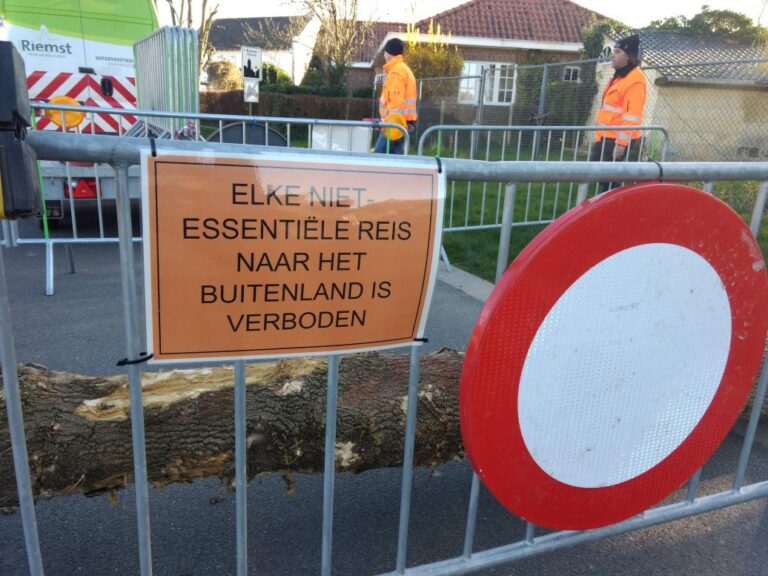Cross-border non-coordination
Yesterday I was in Maastricht near the Belgian border which is no more than 1 kilometre behind my house. I wanted to see it with my own eyes: the border was closed. The Belgian government put up barriers to prevent us from entering the country. At ITEM, we have been working for five years to reduce the existing legal and tax problems in our cross-border Euroregion. And now the border is closed. The road is closed. This, of course, is the opposite of successful Euroregional integration.
How did it come to this? You could say, of course, because of the protection of our health. After all, closing borders helps keep infection rates low. But that is probably only half true. From today’s perspective, people should probably have been prevented from entering the EU from different parts of the world earlier. Or when the first cases came to light, individual hotspots in the EU should have been closed down sooner, as was attempted belatedly in Italy with the North. But these hotspots had little to do with national borders. For instance, the German district of Heinsberg was not separated from Dutch Sittard on the other side of the border, but neither was it separated from the rest of North Rhine-Westphalia (the German state where Heinsberg is located).
Closing borders expression of national impotence
So in Germany, nobody comes up with the idea of closing the border between North Rhine-Westphalia and Lower Saxony. Or to close Bavaria, where the first German cases appeared. That would make more sense than closing national borders to isolate hotspots. So closing the border between Germany and Belgium is actually quite remarkable. It is an expression of national powerlessness because no other coordination tools are available.
Health systems too focused on national scope
Apparently, it was not possible to coordinate the procurement of testing equipment and its solidarity exchange to test as many people as possible in the affected regions. It was also apparently not possible to organise early help from other member states for northern Italy.
The question then arises whether health systems with an entirely national scope can meet the challenge of a cross-border crisis. ITEM will analyse at a later stage the extent to which the EU has taken action on procurement of materials and respiratory equipment, or on coordination of hospital capacity. The European Commission has launched an accelerated joint procurement procedure with 26 member states, according to its recent corona-related “questions and answers”. Under this procedure, the Commission will procure equipment based on the EU Civil Protection Mechanism (rescEU). This could lead to first purchases in early April, if approved by member states. However, as this action comes rather late, we can say that action at EU level was prevented by a lack of powers. And this is not surprising: according to the health article in the Treaty (Article 168 TEU), the Union can only support Member States individually. However, cooperation depends entirely on their willingness.
Another assumption is that even well-integrated neighbours with cross-border governance systems, such as the Nordic countries (the Nordic Council), seem to have few coordination options in this case. Denmark, for instance, closed its border with neighbouring Sweden out of concern for its own healthcare system. What the Benelux countries could have done better during the crisis will be examined later. This includes the role of the Euroregions and the hitherto well-functioning networks of hospitals and emergency services such as EMRIC in the Meuse-Rhine Euroregion.

Lack of coordination of national measures
Why is the border between the Netherlands and Belgium now closed to everyone for no good reason? Not so much because of corona cases on both sides of the border. It is more because of the lack of coordination of national measures. When the shops were already closed in Belgium, they were still open in the Netherlands. So Belgians came to Maastricht in droves to shop. And when much stricter measures were already in place in Belgium, Dutch day tourists apparently acted as if this did not concern them. Was that predictable? Actually, yes. For many people, the Euroregion is part of their normal daily lives, where borders are hardly noticed. If drastic unilateral measures are taken so quickly that information can barely reach people, it creates problems. Meanwhile, the government in North Rhine-Westphalia announced that it had set up a cross-border task force with the Netherlands and Belgium last week. This is hugely important.
The example of Austria showed how limited the effect of closing national borders is. There, the government had closed the border with Italy early on, including South Tyrol (also part of a vibrant Euroregion). In the two ski resorts in Austrian Tyrol, however, the lifts were closed much too late, while it is precisely there that masses probably contributed to the spread of the virus. Moreover, people were able to travel from the ski resorts to the rest of Austria or southern Germany and carry the virus with them.
The same pattern of lack of cross-border coordination was evident across Europe. One border after another was closed and neighbouring countries had hardly coordinated measures. It was rather a case of: save who can. So just a few days ago, more than 50 kilometres of trucks were stuck in traffic jams at the Polish border and conditions for drivers were chaotic. To date (25.3.2020), the German-Dutch border is apparently the only one in the EU where no checks are carried out. Many borders are completely closed, as was recently unthinkable: even for border commuters, e.g. those who want to travel from Germany to work in the Czech Republic.
Finally, there is good news in terms of solidarity: Italian patients are treated in Saxony and French patients from Alsace in Baden-Württemberg. It will also be interesting to explore how this was made possible. Every year, we present our ITEM Cross-Border Impact Assessment. This year, we will examine issues such as: what are the effects of the Corona crisis is on life in border regions and the effects of cross-border coordination, or non-coordination, of crisis response? We will publish the results of the report in November this year.
By Martin Unfried, researcher at Institute for Transnational and Euregional cross border cooperation and Mobility / ITEM

